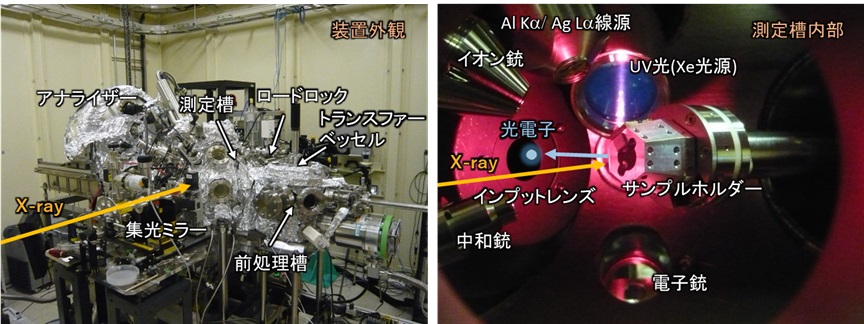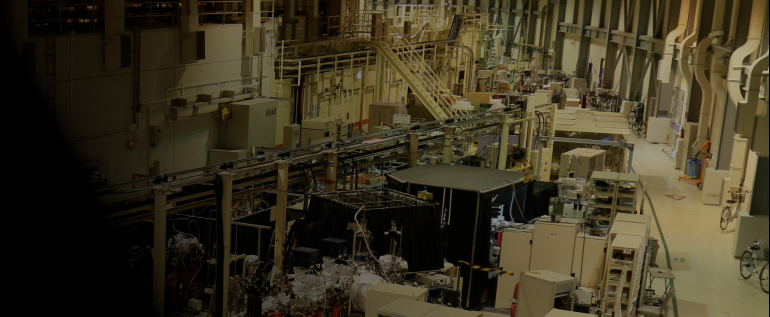汎用硬X線光電子分光装置
◆装置概要
BL46XUの第2ハッチには、Scienta Omicron製のR4000L1-10kV及びFOCUS製HV-CSA 300/15をそれぞれ光電子エネルギー分析器として備える2台のHAXPES装置がタンデムで設置され、実験の種類や使用するX線エネルギーに応じた使い分けをしています。

◆装置の特徴
・R4000L1-10kV装置本装置を用いた実験では,DCM(Si (111))とCCM(Si(333), Si (444), Si (555))の組み合わせで 5.95 keV,7.94 keV,9.92 keV のいずれかの励起エネルギーを選択可能です。通常は光のバンド幅と強度のバランスが良い約 7.94 keV(DCM(Si(111)) + CCM(Si(444)を利用しています。湾曲機構付き Rh コートミラーにより水平方向の集光と高次光除去を行い,楕円ミラーにより鉛直方向の集光が行っています。測定位置におけるビームサイズは半値幅で,水平方向で 250 μm 程度,鉛直方向で 20 μm 程度になります。本装置に装備されるR4000-10 keVは半球(hemispherical)型の分析部を持つ電子分光器で10 keVまでの光電子の測定が可能です。制御ソフトはSES software(Scienta Omicron製)を用いており、モーターコントローラーと連動させることで複数の試料位置及びエネルギー領域に渡る連続自動測定が可能で効率のよい実験を行うことが可能です。
・HV-CSA 300/15装置
本装置を用いた実験では,通常DCMのSi (333)反射で単色化した14 keVのX線を励起光として利用しています。R4000装置の場合と同様に,湾曲機構付きRhコートミラーにより水平方向の集光と高次光除去を行っています。測定位置におけるビームサイズは半値幅で,水平方向が200 μm程度,鉛直方向が400 μm程度になります。本装置に装備される Focus 社製 HV-CSA 300/15 は円筒扇(cylindrical sector)型の分析部を持つ電子分光器で,最大15 keVまでの光電子を分析出来る事が特徴です。制御ソフトはProCSA(Focus製)を用いています。
◆装置アクセサリー
R4000装置
・電子中和銃(~10 eV)
・電子銃(200 eV ~ 20 keV)
・Ar+イオン銃 (10 V~ 5 kV)
・トランスファーベッセルによる大気非暴露試料導入機構
・加熱ステージ(室温~500度程度まで)
・電圧印加ステージ(最大6端子)トランスファーベッセルによる大気非暴露導入可能
・バンドギャップ励起用キセノン光源照射装置
HVCSA装置
・電子中和銃
・トランスファーベッセルによる大気非暴露試料導入機構
共通設備
・Os(オスミウム)コーター (帯電対策用)
・Cコーター (帯電対策用)
◆実験・試料準備
実験は測定準備として、測定室への試料の導入と真空引きに約0.5~2時間を要します。※測定に要する時間は、試料の組成や測定ピーク数等に大きく依存するため、事前にご相談下さい。
◆実験手順・注意事項
・測定配置および試料取付方法説明
http://support.spring8.or.jp/HAXPES/alignment_and_sample_preparation.pdf
・試料導入マニュアル
http://support.spring8.or.jp/HAXPES/sample_loading_manual.pdf
・自動測定システムマニュアル()
http://support.spring8.or.jp/HAXPES/auto_system_manual.pdf
◆問い合わせ先
安野 聡 このメールアドレスはスパムボットから保護されています。閲覧するにはJavaScriptを有効にする必要があります。
◆代表的な論文リスト
“Graphite‐Silicon‐Polyacrylate Negative Electrodes in Ionic Liquid Electrolyte for Safer Rechargeable Li‐Ion Batteries”
Naoaki Yabuuchi
Advanced Energy Materials, 1, (2011) 759-765
DOI : 10.1002/aenm.201100236
"Aerobic Oxidative Coupling of Alcohols and Amines over Au–Pd/resin in Water: Au/Pd Molar Ratios Switch the Reaction Pathways to Amides or Imines"
Zhang Leilei
Green Chemistry, 15, (2013) 2680-2684
DOI : 10.1039/c3gc41117f
"Direct Measurement of Band Offset at the Interface between CdS and Cu2ZnSnS4 using Hard X-ray Photoelectron Spectroscopy"
Tajima Shin
Applied Physics Letters, 103, (2013) 243906
DOI : 10.1063/1.4850235
"Sodium Carboxymethyl Cellulose as a Potential Binder for Hard-Carbon Negative Electrodes in Sodium-Ion Batteries"
Dahbi Mouad
Electrochemistry Communications, 44, (2014) 66-69
DOI : 10.1016/j.elecom.2014.04.014
"Highly Reversible Capacity at the Surface of a Lithium-rich Manganese Oxide: a Model Study Using an Epitaxial Film System"
Taminato Sou
Chemical Communications, 15, (2015) 1673-1676
DOI : 10.1039/c4cc07758j
General-Purpose Hard X-ray Photoelectron Spectrometry Equipment
◆Equipment overview
In the second hatch of BL46XU, two HAXPES photoelectron energy analyser devices are installed in tandem, R4000L1-10kV made by Scienta Omicron and HV-CSA 300/15 manufactured by FOCUS, which both can be used according to the type of experiment you desire, and the X-ray energy you have.

◆Features of the Equipment
・R4000L1-10kv EquipmentWith experiments using this equipment, excitation energies of 5.95keV, 7.94keV or 9.92keV can be selected and combined with DCM(Si(111) and CCM(Si(333), Si(444), Si(555)). Normally, approximately 7.94keV (DCM (Si(111)) + CCM(Si(444))) is used, which has a good balance of light bandwidth and intensity. The Rh coat mirror with a bending mechanism collects light in the horizontal direction and removes higher-order light, and the elliptical mirror collects light in the vertical direction. At the measurement position, the beam size is full width at half maximum, approximately 250 μm horizontally and 20 μm vertically. Equipped with the R4000-10keV is a dome-shaped (hemispherical) analyser, which is capable of measuring electron spectrographs for photoelectrons up to 10keV. The control software used is SES software (manufactured by Scienta Omicron), and when linked with a motor controller, continuous automatic measurement over various sample positions and energy regions are possible, which enables efficient experiments.
・HV-CSA 300/15 Equipment
For experiments that use this equipment, 14 keV X-rays which have been mono-colorized by DCM Si(333) reflection are generally used as the excitation light. As in the case of the R4000 equipment, the Rh coat mirror with a bending mechanism collects light in the horizontal direction and removes higher-order light, and the elliptical mirror collects light in the vertical direction. At the measurement position, the beam size is full width at half maximum, approximately 200 μm horizontally and about 400 μm vertically. This system is equipped with Focus HV-CSA 300/15, which is a cylindrical fan (cylindrical sector) shaped electron analysis spectrometer, which can analyse photoelectrons up to 15 keV. The control software used is ProCSA(made by Focus).
◆Equipment accessories
R4000 Equipment
・Electron neutralization gun (~10 eV)
・Electron Gun (200 eV ~ 20 keV)
・Ar+ Ion Gun (10 V~ 5 kV)
・By using a transfer vessel the sample can be introduced without exposure to the atmosphere
・Heating Stage (Room temperature ~ 500 degrees)
・The voltage application stage (up to 6 terminals) can be introduced without exposure to the atmosphere by using the transfer vessel
・Xenon irradiation equipment for bandgap excitation
HVCSA Equipment
・Electron neutralization gun
・By using a transfer vessel the sample can be introduced without exposure to the atmosphere
Shared Equipment
・Os (Osmium) coater (antistatic agent)
・C coater (antistatic agent)
◆Experiment / sample preparation
In preparation for measurements, it takes between 0.5 to 2 hours to introduce the sample into the measurement chamber then prepare the vacuum. ※Please contact us in advance, as the time requires for measurements largely depends on the composition of the sample and the number of peaks to be measured.
◆Experimental procedure / precautions
・Explanation of measurement configurations and sample installation instructions.
http://support.spring8.or.jp/HAXPES/alignment_and_sample_preparation.pdf
・Sample Introduction Manual
http://support.spring8.or.jp/HAXPES/sample_loading_manual.pdf
・Automated Measurement System Manual
http://support.spring8.or.jp/HAXPES/auto_system_manual.pdf
◆Contact
安野 聡 このメールアドレスはスパムボットから保護されています。閲覧するにはJavaScriptを有効にする必要があります。
◆List of representative treatises
“Graphite‐Silicon‐Polyacrylate Negative Electrodes in Ionic Liquid Electrolyte for Safer Rechargeable Li‐Ion Batteries”
Naoaki Yabuuchi
Advanced Energy Materials, 1, (2011) 759-765
DOI : 10.1002/aenm.201100236
"Aerobic Oxidative Coupling of Alcohols and Amines over Au?Pd/resin in Water: Au/Pd Molar Ratios Switch the Reaction Pathways to Amides or Imines"
Zhang Leilei
Green Chemistry, 15, (2013) 2680-2684
DOI : 10.1039/c3gc41117f
"Direct Measurement of Band Offset at the Interface between CdS and Cu2ZnSnS4 using Hard X-ray Photoelectron Spectroscopy"
Tajima Shin
Applied Physics Letters, 103, (2013) 243906
DOI : 10.1063/1.4850235
"Sodium Carboxymethyl Cellulose as a Potential Binder for Hard-Carbon Negative Electrodes in Sodium-Ion Batteries"
Dahbi Mouad
Electrochemistry Communications, 44, (2014) 66-69
DOI : 10.1016/j.elecom.2014.04.014
"Highly Reversible Capacity at the Surface of a Lithium-rich Manganese Oxide: a Model Study Using an Epitaxial Film System"
Taminato Sou
Chemical Communications, 15, (2015) 1673-1676
DOI : 10.1039/c4cc07758j
